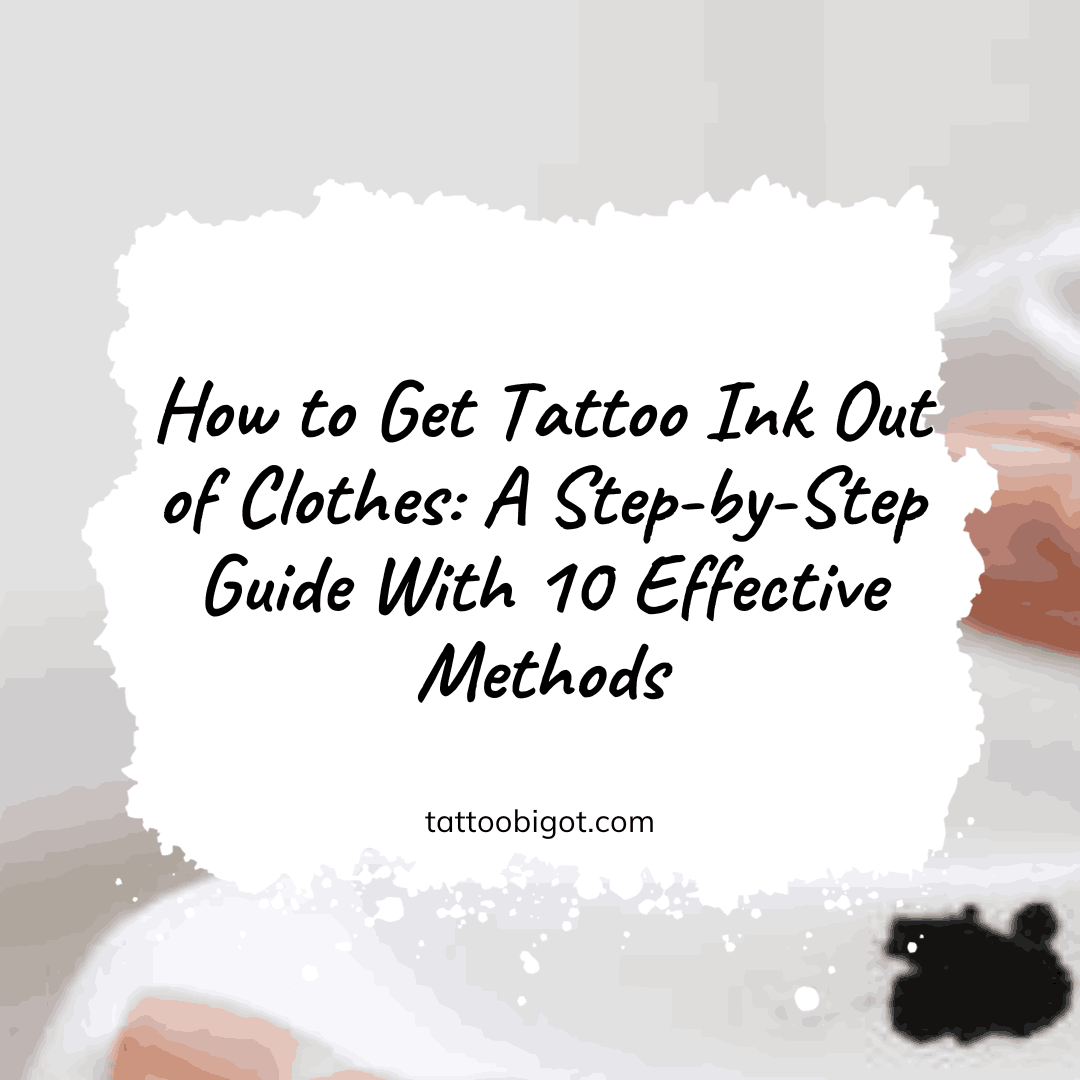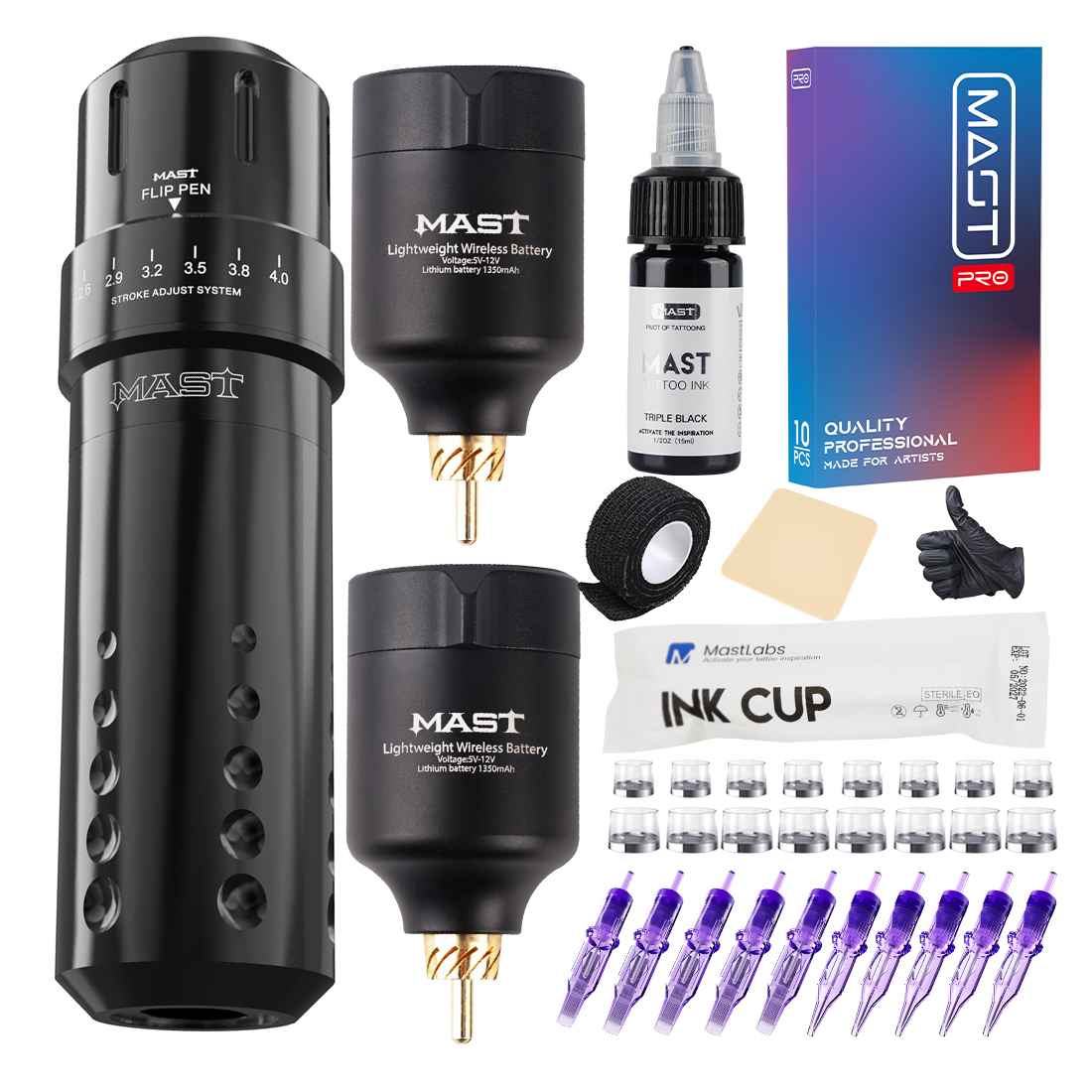The sight of a fresh tattoo ink stain on your favorite white blouse is enough to make your heart sink. You watch in horror as the vibrant blotch of color bleeds through the delicate fabric.
Though the damage seems devastating at the moment, don’t despair. Removing tattoo ink from clothing is possible, even if the stain has already dried. With some handy household products and a little perseverance, you can salvage your garment and lift that ink right out.
This comprehensive guide will walk you through how to get tattoo ink out of clothes. You’ll learn the best DIY methods for tackling tattoo ink based on the stain’s age and fabric type.
Learn how everyday items like rubbing alcohol, lemon juice, hairspray, and more can dissolve pigments when used properly.
Find out when to let the pros handle certain extra-delicate fabrics. And know when to throw in the towel if a stain refuses extraction without destroying the clothing.
Arm yourself with the stain-fighting knowledge needed to erase fresh or set-in tattoo ink. With the simple but highly effective product and technique recommendations here, you can ensure the longevity of clothes sporting impossible-looking blotches.
Get ready to breathe new life into pieces you thought were headed for the donation pile.
How to Get Tattoo Ink Out of Clothes (10 Effective Methods)
Removing tattoo ink from clothes can be a daunting task, but with the right methods, it’s entirely manageable. Whether you’re dealing with fresh stains or older marks, these ten effective techniques will guide you in restoring your clothes to their ink-free state.
1. Check the Fabric and Ink Type
Before attempting to remove a tattoo ink stain, you need to assess some key characteristics to determine the best approach.
Taking the time to analyze the fabric, ink type, color vulnerability, and age of the stain upfront will ensure you use an appropriate removal method that is less likely to damage the clothing.
a. Identify Fabric Type
Knowing the exact fabric you are working with is crucial when stain removal is the goal. More delicate materials like silk or wool often require special care without harsh chemicals that could ruin them.
Sturdy fabrics like cotton and polyester have a higher tolerance for intensive scrubbing, chemical solvents, or heat during treatment.
Blends combine qualities of multiple textiles, so identify all materials present. Inspect garment tags for percentages and specific fabric names in the content listing for helpful insight.
b. Determine Ink Age
Assessing the age of an ink stain is also useful prep knowledge. The longer a stain sets, the harder it is to lift in most cases. Fresh wet ink has not had time to fully adhere to fibers or oxidize and change chemical composition.
So, removal techniques can be more aggressive upfront for timeliness. However, dried or old stains often warrant letting solvents penetrate for longer periods or repeating processes like rinsing and resoaking multiple times.
Identify how long ago ink made contact based on the wearer’s recall or stain border saturation.
c. Consider Color Vulnerability
When ink stains white or light-colored clothing, the high contrast makes the discoloration glaringly obvious early on.
However, the entire color depth present in the fabric provides space for the stain’s pigment to transfer and possibly blend in.
On darker clothing, a stain may initially appear less noticeable. Still, over time, the ink can spread out and surface as lightened patches.
So, factor the original color and purity into urgency and expectations with stain treatment intensity or duration.
2. Act Quickly for Fresh Ink
When tattoo ink makes contact with fabric, and the stain is still wet, the prompt reaction is key for lifting the pigment before it has a chance to set in.
Time is of the essence, so employing a rapid response system boosts your chances of complete removal.
a. Blot Excess Ink Immediately
As soon as you notice the wet ink;
- Use an absorbent cloth or paper towels to blot lift excess pigment. This should be the number one priority.
- Gently press and soak up as much as possible without pushing down too firmly, or you may drive the stain deeper into the fibers.
- Lift straight up to pull ink out rather than wiping across, which can spread its perimeter.
- Continue blotting with fresh areas of cloth until no more transfer of color occurs.
b. Rinse With Cold Water
After absorbing surface-level moisture:
- Run the fabric under a heavy stream of cold water to flush ink residue.
- Check the backside of the garment frequently to gauge effectiveness as water permeates layers toward the stain’s underside.
- Continue rinsing for several minutes to carry away any free pigment through to the other side.
c. Use Alcohol, Acetone, or Hairspray
Once excess ink is hand blotted and then water rinsed, applying a solvent like rubbing alcohol, nail polish remover, or hairspray is beneficial for breaking up and dissolving the remaining traces.
Ensure the product used aligns with fabric warnings and care instructions. Check treatment in a hidden seam if uncertain how the textile will react.
Spray or pour small amounts directly atop the stain, let penetrate fabric for 30 seconds or up to 2 minutes, then rinse again.
3. Use Rubbing Alcohol for Dried Ink
When a tattoo ink stain has already dried on fabric, rubbing alcohol is one of the most reliably effective home treatment options.
The solvent properties in various strengths of isopropyl alcohol lift and dissolve pigment, making it a staple for combatting set-in discoloration.
a. Check Garment Care Instructions First
Before dousing any fabric in alcohol, refer to the manufacturer’s care label stitched inside garments for any warnings against use.
Labels may specifically prohibit alcohol, bleach, and other harsh chemicals if dyes or fabric structures are vulnerable to damage.
Using rubbing alcohol on fabrics prone to disintegration from it can make stains worse. Seek professional help for dry-clean only clothes if uncertain.
b. Apply Rubbing Alcohol and let it sit.
If fabric care supports it;
- Use a cotton pad or ball to directly apply rubbing alcohol atop the dried ink stain.
- Ensure the discolored area is fully saturated, then let it remain undisturbed for 10-20 minutes.
- This gives the solvent time to break down pigment bonds so they can then be released from fibers.
- Reapply more alcohol if the area begins drying out while soaking.
c. Rinse and Repeat If Needed
After adequate soak time:
- Rinse the back of the fabric well with cool running water.
- Check for ink lifting by watching for color streaming out.
- Launder as usual afterward and allow to fully dry. If any residual staining remains, repeat the concentrated alcohol treatment and rinse process until no more color transfers.
Multiple applications may be required for significant set-in stains.
4. Try Hairspray or Nail Polish Remover
In addition to alcohol, hairspray, and nail polish remover offer solvent attributes useful for tackling dried tattoo ink stains without a trip to the dry cleaners. The acetone and alcohol content interact with fabric differently but can still loosen pigment grip when used properly.
a. Try Nail Polish Remover
Double-check your garment’s care guidance first, then test the nail polish remover containing acetone on a hidden area of fabric.
100% acetone formulas are the harshest, while “acetone-free” is gentler but still effective. Soak a cotton ball then tamp directly onto stain for 2-5 minutes. Rinse, then check for progress in lifting the ink.
b. Use Hairspray for Stain-Fighting Power
The alcohol content within various hairspray brands bestows unique stain-removal abilities. Avoid highly flammable aerosol sprays in favor of pump hairsprays.
Mist the formula directly atop stubborn dried ink stains, rewetting periodically over 10-15 minutes before rinsing out thoroughly. The stain fighters interact with pigments, allowing easier release from fabric.
Also Read: How to get tattoo ink out of carpets
5. Make a Baking Soda Paste
Mixing baking soda with a bit of water to form a spreadable paste creates an effective home remedy for tackling set-in tattoo ink stains. The chemical properties of the sodium bicarbonate work to literally pull pigment particles out from fabric fibers.
a. Make a Thick Baking Soda Paste
- In a small bowl, gradually mix a 1:1 ratio of baking soda powder with cool water.
- Add just enough to form a thick, spreadable paste similar to toothpaste or putty.
- Too much water will make the mix runny and ineffective.
- Stir slowly with a spoon until uniform.
b. Apply Paste to Stain for 1-2 Hours
- Use an old toothbrush, cotton swab or dull knife to actively work the baking soda paste completely over the fabric stain area.
- Apply paste thickly and extend just past the stained perimeter.
- Allow the paste to sit undisturbed for 60-90 minutes.
- As it dries, baking soda will extract pigment from fibers.
c. Rinse Out, Then Launder as Usual
After ample dwell time:
- Use a soft bristle brush and run cool water to rinse away all remnants of dried paste.
- Check the fabric closely for stain remnants or lightening.
- For optimal results, launder the garment normally after rinsing to carry away all lifting residue.
- Allow to fully air dry then recheck area.
- Repeat the process if any lingering discoloration remains before wearing it again.
The abrasive but fabric-safe properties in baking soda offer an effective stain-fighting mechanism without harsh chemicals when done properly. The lengthy treatment time allows its color-lifting powers to work for stunning results.
6. Use Lemons or White Vinegar
Natural acid solutions found in common household staples like lemon juice and white vinegar make them surprisingly adept at dissolving stubborn dried tattoo ink stains. Their high acid content literally breaks down pigment particles.
a. Apply Lemon Juice to Stain
Freshly squeezed lemon juice is a shop-at-home stain fighter with some serious muscle. Thanks to citric acid, this common cooking ingredient offers effective fabric stain removal powers.
- Slice a lemon in half and squeeze ample juice to entirely cover the fabric stain.
- Let lemon juice dwell for 5-10 minutes.
- As acids interact with fabric and lift color traces from fibers, blot periodically with a cloth.
b. Use White Vinegar Instead
White vinegar is the workhorse of DIY stain removal thanks to acetic acid. Like lemon juice, its acidic nature breaks down stubborn discoloration for easier removal.
- Pour undiluted white vinegar directly onto ink stains.
- Check fabric care guidance first for fiber limitations.
- Let set without disturbance for up to 15 minutes
- Then rinse the stain area well with cool water and launder as usual.
Lemon juice and vinegar both capitalize on acidic properties to tackle tricky stains. Allowing ample dwell time for their interactions with fabric maximizes tattoo ink color lifting without the harshness of chemical cleaners. Rinsing and washing promptly after treatment ensures the removal of all residue.
7. Try Salt or Club Soda
Abrasive salts and bubbly club soda offer stain-fighting assistance for tattoo ink marking up your clothes. Both pantry items use different mechanisms to help strip out pigment from fabric fibers without harsh chemicals.
a. Try Salt for Abrasive Action
Table salt harnesses abrasive qualities in tandem with liquid for its stain attack plan.
- Form a paste by stirring fine-grained salt with warm water, then work it thoroughly into the affected fabric area.
- The gritty salt works like an exfoliant for fabric, lifting embedded ink particles out with friction but not intense enough to cause fabric damage.
- Let salt paste dwell for 5-10 minutes, then flush with water and launder.
b. Spray with Club Soda
Once reserved for mixing cocktails, plain unflavored club soda has a developing fan base for its laundry stain removal prowess instead.
- Pour club soda generously atop ink stains or lightly spray it on instead.
- As the carbonated water saturates fabric, it creates bubbles that help lift pigment up and out of fibers.
- Allow club soda to fully flatten and go flat, about 5 minutes, before rinsing and washing the garment.
- The extended bubble bath continues lifting stains over time without any rubbing required.
Both salt and club soda offer screen-free stain-fighting options right from your kitchen. Their abrasive and bubbly magic makes short work of that tattooed fabric ink disaster without damage.
Also Read: How to get tattoo ink out of couches: Easy Methods for Stain Removal
8. Use a Commercial Stain Remover
For the most stubborn tattoo ink stains that resist all home treatment efforts, turning to a commercial-strength stain remover could offer the extra muscle needed. Seek out enzyme-based formulas designed for long set-in stains.
a. Test Ink Remover on Inconspicuous Area First
To prevent possible irreversible damage:
- Always check any store-bought stain remover on garment interior seams first.
- Apply a small amount, let sit per directions, then rinse and inspect for issues with dye bleeding or structural weakening.
- If fabric shows distress, discontinue use.
b. Apply Per Package Instructions
Once tested, with fabric showing tolerance, apply targeted stain remover to ink spots following the included instructions.
- Many suggest letting the solution sit for 5-30 minutes before rinsing, while others require reapplication every 1-2 minutes for maximum effectiveness.
- Do not allow stains to dry again before washing.
c. May Require Multiple Applications
The most severe ink stains often demand repeated applications before lifting, even with commercial removers.
- Reapply the product over previously treated areas according to instructions until no more color transfers out.
- Be patient but persistent if you choose to employ harsher chemical options, ceasing use immediately if fabric shows any new damage.
Here’s the best commercial-strength stain remover right now.
9. Wash Normally After Treatment
After completing any treatment for removing tattoo ink from clothing, properly washing the garment is imperative as the final step before wearing it again or drying it. Laundering serves to completely rinse away all lifting agents from fibers and ensure no residue remains.
a. Wash Normally After Stain Treatment
Once ink stains are no longer visible or able to be lifted further with home remedies, launder items normally following care label instructions.
- Use your regular laundry detergent and approved wash method to work lingering treatment remnants entirely through the fabric.
- This gives a final chance for any loosened pigment particles to fully release.
b. Avoid Heat Drying Until the Stain Gone
- Line or flat dry garments after wash cycles as heat from dryers can set any remaining staining or product buildup more permanently.
- Avoid dryers until all traces of ink are fully cleared, even if stains are no longer visible when wet.
- The heat sealing can render them impossible to remove by any future efforts if pigment lingers unseen.
c. Repeat the Removal Process If Stains Resurface
Ink stains that reappear after initial treatment and standard washing require repeat rounds of stain-fighting efforts.
- Be sure to check items closely once fully dry and holding up to bright light.
- Any shadows, –tones, or faint residue means ink still clings within fibers, so the removal process needs repetition.
- Perseverance is key for total elimination.
Proper laundering is vital to finish the ink removal job as well as protect your garments after aggressive stain treatment. So pay close attention to avoid prematurely sealing stains while drying or stopping too soon if hints linger after washing.
10. When to Give Up Getting Tattoo Ink Out of Clothes
As disheartening as a remaining tattoo ink stain might be after multiple removal attempts, sometimes you have to accept defeat. Knowing when to throw in the towel depends greatly on how the fabric responds to continued treatment.
a. Ink Won’t Budge After Multiple Tries
Suppose you have progressively worked through multiple recommended home remedies like alcohol, vinegar, hairspray, and more without any lifting success.
In that case, the ink stain may have been set permanently. If abrasives like salt, baking soda, and club soda also show no results either alone or in sequence, it’s best to move on.
Harsher chemical stain removers could damage the fabric beyond repair if simpler options have already failed.
a. Avoid Harsh Treatment on Delicate Fabrics
Extra fragile fabrics like silks, wools, and chiffon often cannot endure intensive stain removal tactics of any kind without irreversible damage.
Their fibers and dyes leach or decay quickly, even with gentle cleaning attempts. Seek professional dry cleaning first to see if a miracle can be managed. Otherwise, let go of salvage hopes before dissolution occurs.
b. Ink Removal Damages Fabric
Sometimes, the act of treating a stubborn stain itself compromises fabric integrity regardless of the method. Noticeable thinning, holes or structural weakening signals it’s time to stop your pursuit of perfection.
Ink stains in well-worn clothing may indicate the last leg of useful life has been reached. Repurpose damaged goods into cleaning rags. Know when further efforts cause more wasteful harm than isolated discoloration.
As difficult as surrendering your stain removal efforts might be, preserving the lifespan of your garments should take priority when risks develop. Focus efforts on fresh stains in newer items for best outcomes.
Conclusion
When tattoo ink stains suddenly materialize on your favorite attire, prompt action offers the best odds for averting permanent discoloration disaster.
As soon as fresh wet ink appears, blot promptly, then flush with cold water before applying a solvent like rubbing alcohol or hairspray.
For dried and set-in stains, rubbing alcohol, nail polish remover, vinegar, lemon juice, and baking soda pastes dissolve pigment particles upon lengthy exposure.
Diligent rinsing and normal washing afterward ensure no residue remains. If stains refuse to lift despite these home treatments, consult a dry cleaning pro for stronger commercial agents.
However, discontinue methods causing any fabric damage and know certain extra delicate textiles have no tolerance.
While complete stain eradication might not always be guaranteed, the array of techniques covered here provides a fighting chance at redemption for marked-up garments using affordable household supplies.
With this comprehensive stain-fighting intel, on how to get tattoo ink out of clothes, in your arsenal now, you can rescue treasured clothing from the darkness of tattoo ink despair – lifting spots and restoring their original glory.
FAQs
Does toothpaste remove tattoo ink from clothes?
Yes, toothpaste can help lift some tattoo ink due to abrasives that break down stains. Make a paste with water, apply to ink for 5 mins, rinse, then wash normally. It may require repeat applications.
What removes fresh tattoo ink stains?
Blotting immediately with a cloth, flushing with cold water, then using rubbing alcohol, hairspray, or nail polish remover on the fresh stain can help lift it before it sets.
Does WD-40 remove ink from clothes?
Yes, WD-40 can break down stubborn ink stains. Spray it on, let it sit for 5-10 minutes, then rinse and wash as usual. Test on an inconspicuous area first.
Can you put clothes with tattoo ink in the dryer?
Avoid putting ink-stained clothes in the dryer until the stain is fully removed. Heat can set and permanently seal any lingering traces of ink into the fabric.
Does tattoo ink come out of white clothes?
Yes, tattoo ink can be removed from white clothes using abrasives, solvents like alcohol or acetone, or bleach if the fabric allows. Stains show plainly on white, but it also makes progress easier to monitor.
Can Clorox remove ink stains from clothes?
On white clothes or safe-for-bleach fabrics, Clorox can help lift set-in stubborn ink stains after other methods fail. Always spot-test first.
How do you get pen ink out of clothes at home?
Rubbing alcohol, hairspray, vinegar, lemon juice, or commercial stain sticks can all remove pen ink at home. Blot fresh stains quickly, then work remover into fabric for 5-10 minutes before rinsing and washing.






